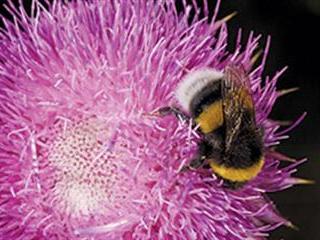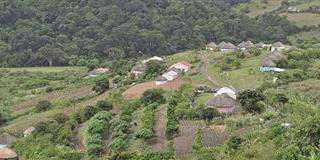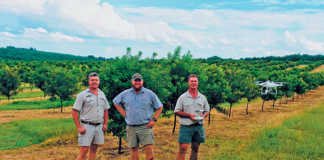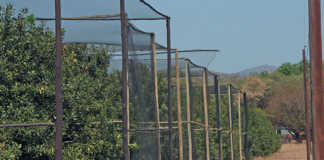
Photo: Anton Pauw
A recent article ‘Bumblebees fly to the rescue’ (Farmer’s Weekly, 12 April) reported on a newly patented beehive concept developed in Belgium. The system enables bees to deliver microbial fungicides and insecticides directly to flowers. The Belgians make use of bumblebees and suggested that South African farmers could do the same, but this is certainly not the case.
READ: A common purpose for agriculture
Should we use bumblebees
The Directorate of Plant Health at the Department of Agriculture confirmed that insects, including bees, can be imported with a permit, which will be issued only after a thorough risk assessment. Importing bumblebees has not been approved and the idea should be approached with extreme caution.
What is a bumblebee?
Many people confuse the indigenous South African carpenter bees (Xylocopa species) with bumblebees. Carpenter bees are solitary and nest in tunnels in wood; bumblebees are social insects that form colonies in underground nests. Bumblebees (genus Bombus) are mostly from Europe, Asia and parts of the Americas.
The bumblebee mentioned in the “Bumblebees fly to the rescue” article is Bombus terrestris, the large earth bumblebee from Europe. Since the 1980s, farmers in Europe and other parts of the world have been able to buy B. terrestris hives as an ‘off the shelf’ product, mostly for greenhouse pollination of crops such as tomatoes.
Potentially harmful
Experience in other countries shows that bumblebees would be a serious hazard to South African biodiversity and agriculture. Firstly, they would threaten local pollinator species by competing for flowers and nesting sites, and possibly by transmitting new diseases.
Secondly, they could affect indigenous vegetation by reducing pollination of these species. Thirdly, they could worsen our problems with invasive plant species by improving their seed production.
Five years after being introduced to New Zealand to pollinate red clover, B. terrestris had naturalised and begun to spread at 90km per year. Since the 1990s, they have spread into the wild from hives used for crop-pollination in Japan, Israel, and Chile, and then to neighbouring countries. They reached Argentina from Chile and, presumably with human assistance, arrived in Tasmania from New Zealand.
Their ability to invade new habitats seems to be linked to their unique biology. They are social bees and their queens can concentrate on reproduction while the workers forage, resulting in rapid population growth. They can survive in a wide range of climates, have flexible nesting habits and can use many different flower species for food. This combination of characteristics means that B. terrestris are usually very numerous.
In addition, their exceptional tolerance of cold allows them to forage earlier in the morning than other species, enabling them to consume available pollen and nectar before other bees can reach it. B. terrestris is now the most common bee in many invaded areas.
They can only achieve such high numbers at the expense of indigenous bee species. Following introductions to Japan and Argentina, B. terrestris numbers have increased while native bee species have declined.
South Africa has many unique bee species that could be threatened if bumblebees were introduced here. Some native species specialise in visiting one or perhaps a handful of plant species and could face extinction if bumblebees were to outcompete them for pollen and nectar.
While honeybees, like bumblebees, feed on many flowering species, they would also be adversely affected by competition. Honeybees would not become extinct due to competition, but they are already under pressure due to limited forage and reduced numbers.
This means that lower honey yields for beekeepers are a possibility if bumblebees become established. Unlike honeybees, bumblebees cannot be used for honey production. Bumblebees are also bad for many non-bee pollinators and the plants they pollinate.
Plants pollinated by sunbirds, for example, have a floral tube adapted to fit the bird’s long beak which excludes bees because their tongues are too short to reach the nectar.
Bumblebees, however, are experts at ‘stealing’ nectar by cutting a hole at the base of the flower. This nectar-robbing is bad for both the plant and its natural pollinator – the plant does not get pollinated and the bird does not get its food. An invasion by bumblebees could therefore lead to declines in plants and pollinators, changing vegetation composition and affecting biodiversity tourism in areas such as Namaqualand and the Western Cape.
A boon for invasive plants?
Invasive plants cost South Africa billions of rands annually. Bumblebees are important pollinators of invasive plant species in other parts of the world and could worsen our invasive plant problems by improving seed production of these plants.
For example, they are important pollinators of Paterson’s curse (Echium plantagineum), broom species (Cytisus scoparia, Genista species), brambles (Rubus species) and thistles (including Carduus nutans), which are already a problem.
Bumblebees might even stimulate new invasions. Rhododendron ponticum is a serious invader in Ireland, where it is pollinated by bumblebees (which are native there). Although this plant occurs in South African gardens, it has not become invasive. The arrival of the bumblebee could trigger an invasion similar to that reported in Tasmania.
Taking it from here
Despite potential benefits for crop pollination and fungicide application, it is highly unlikely that the positives of introducing bumblebees to South Africa would outweigh the negatives. Other countries have already reached this conclusion and Bombus terrestris may not be imported to mainland Australia, the US or Canada.
If anyone wants to bring bumblebees to South Africa, a proper risk assessment and permit application is required. We recommend, however, that if farmers require improved pollination services they should pursue alternative strategies. Currently, pollination can be improved by using commercial honeybee pollination services and by providing habitat for other native pollinators near to crops.
Progress has also been made towards commercialisation of other bees, such as carpenter bees (Xylocopa species) and Amegilla species in Australia and Israel, and hopefully this technology can be transferred to South African indigenous bee species.
Various scientists contributed to this article: Dr James Rodger, Stellenbosch University; Prof John Donaldson, SANBI; Dr Connal Eardley, Agricultural Research Council; Prof Anton Pauw, Stellenbosch University; Prof Steve Johnson, University of KwaZulu-Natal; Prof Dave Richardson, Stellenbosch University.
Email Dr James Rodger at [email protected]













